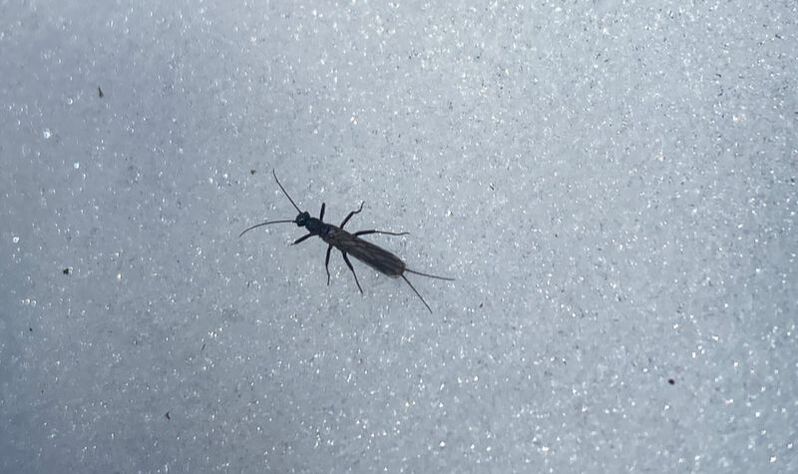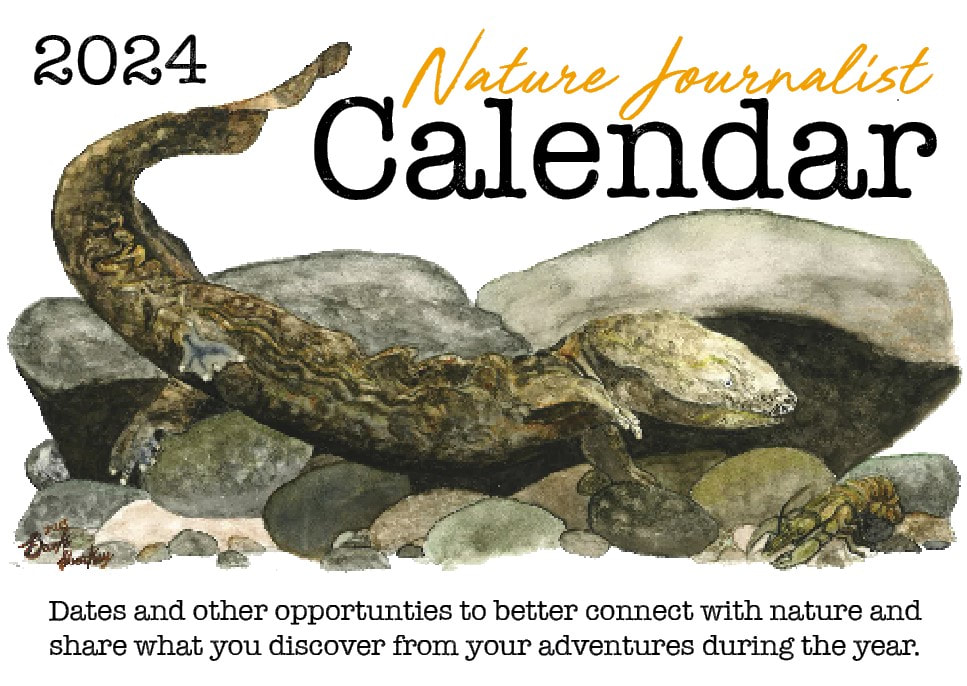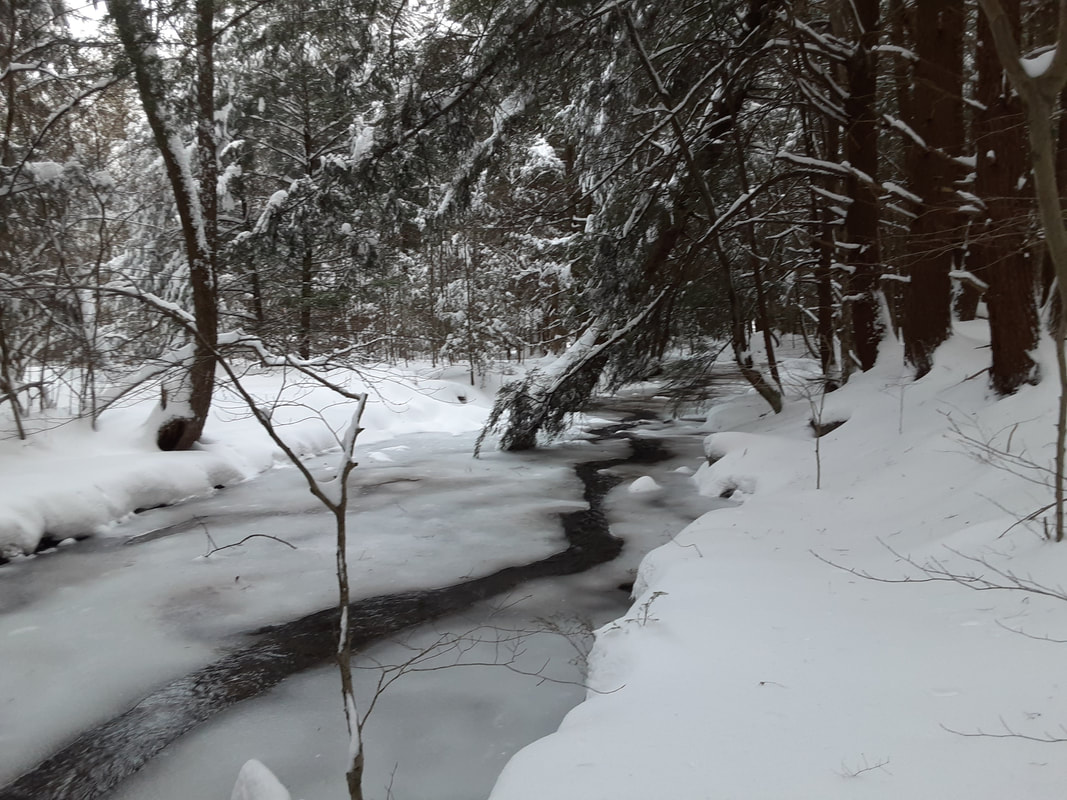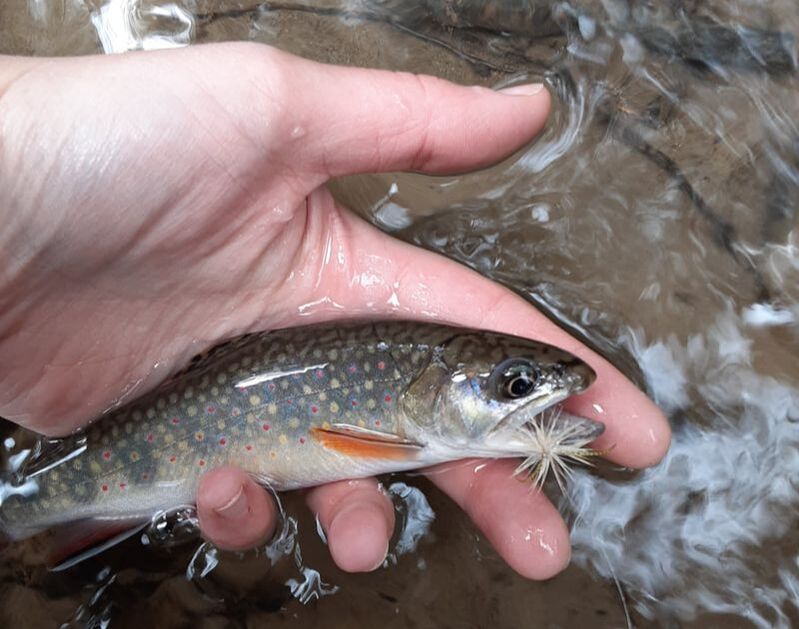Our steams in winter: A look into the challenges and resilience of our waterways through the season2/27/2024 Riverkeeper's Note: The following column was written by Middle Susquehanna Riverkeeper Association Northern Tier Regional Director Emily Shosh. You can contact her via email at [email protected] Life finds a way. Through trials and tribulations, we adapt and overcome. Many would agree the most captivating examples of this can be found in nature, especially through the winter. Take our streams and rivers for example, from the small trickling mountain springs to the steady flowing rivers that receive them. Each piece of the watershed is home to resilient beings who are dependent upon certain environmental and climate cues to survive. The wood frog slows down its organs gradually in order to freeze solid in the mud, later to defrost in the spring. Fish and turtles slow their metabolism and gravitate to deeper water, scuttling along the stream substrate. Aquatic mammals collect an extra layer of fat beneath thick, waterproofed coats. Other terrestrial mammals bury into the snow, where warmth can be found under many insulating inches of snow and ice. Thanks to the autumn's deposited foliage, streams become full of debris which will provide a steady supply of food to the macroinvertebrate aquatic insect world, a keystone of the aquatic food chain.  This curious critter was found near Mill Creek in Coudersport, PA. Small Winter Stoneflies, scientifically known as Family Capniidae, typically emerge as mature adults through the mid to late winter and mostly crawl rather than fly in search of mates. Freeze-avoiding insects like these produce their own antifreeze compounds including glycerol, proteins, and sugars, which enhance their ability to withstand the cold. Photo by Emily Shosh. For example, the peculiarly adapted winter stoneflies (a collection of several stonefly subspecies belonging to the Families Taeniopterygidae and Capniidae) inhabit where water continues to flow beneath stream substrate and gravel. They emerge as winged adults when streambanks are snow covered and can be seen walking on top of the icy landscape. Freeze-avoiding insects like these produce their own antifreeze compounds including glycerol, proteins and sugars, which enhance their ability to withstand the cold. Like winter stoneflies, members of the stream community survive in a delicate dance with local climate. But what happens when this system experiences an unexpected thaw? A flash flood rain event instead of several inches of snow? Snowmelt recharge all at once, and in January? Winter precipitation is one of the most important players in our water cycle for yearly recharge and renewal. No rainfall or snowfall at all has obvious negative effects on the water table and stream levels, especially if followed by a drier year overall. In forested areas, efficient infiltration occurs between November and March, when intermittent rain can be expected to turn to snow and create snowpack. As the snowpack melts, it provides a steady supply of water taken in by the soil and stream gradually as the ground defrosts. However, freeze/thaw periods earlier in this system may affect the infiltration efficiency and even the most robust, well-forested riparian areas will struggle to absorb a sudden mass melt-off of snowpack. This means flooding and the potential for excessive erosion, something that would be amplified in more developed areas experiencing these same weather events. One study in New Mexico from 2022 further explored these consequences. It found that changes in snowpack volume lead to changes in stream metabolism ("the cumulative photosynthetic and heterotrophic activity of algal and bacterial communities”), thereby influencing the aquatic food web and trophic interactions. Over a course of sampling during both La Nina and El Nino years, the study additionally found that stream metabolism in the spring is highly dependent upon winter conditions, and this may extend to summer. Thus, it could be further concluded that winter precipitation changes have the potential to trigger multi-season effects on physical, chemical and metabolic stream processes in approximately 60 percent of river basins in the Northern Hemisphere. With the consistent inconsistency of winter as of the last several years, what does the future look like? Some expectations include changes in species composition, rise in population of generalist species, added stressors to native species and habitat fragmentation. Many of these threats are besieging our local landscapes already. The latest Pennsylvania Climate Impacts Assessment explains that "winter stream temperatures have shown warming trends which present both positive and negative outcomes for fish communities." The report explains that precipitation, whether in the form of snow or rain, still may yield positive influence to the water table thus benefiting fish. However, as previously mentioned, increased water temperatures over time decrease its ability to hold dissolved oxygen - something that our most vulnerable aquatic species require in abundance. One such species is the native eastern brook trout, our Pennsylvania state fish and our only native trout species. Significant fluctuations in water temperatures, water levels, stream vegetation and invasive species are all being exacerbated by climate and remain ongoing threats to the Eastern Brook Trout. For a deeper dive into Brook Trout and Climate Change, check out this objective yet hopeful story map: Brook Trout in a Warming World. While solutions to this issue are not simple, some climate readiness actions can help our infrastructure and vulnerable species. These include but are not limited to maintaining a large riparian buffer of native plants along streams, ensuring the installation of adequately sized culverts and stream crossings that can handle more frequent, increased water flow or collecting stream data to monitor responses to changes in winter. In line with these efforts lies phenology, the study of nature’s timing. With so many closely timed relationships in nature, it is important data to acquire. For instance, many pollinators only emerge once the first spring wildflowers bloom. Climate can influence this immensely. Reporting stream observations, the bloom time of flowers, the emergence of pollinators, etc., can help alert agencies of certain upcoming environmental stressors, which may help influence conservation work decision making through the year. Tools to record these observations include iNaturalist, eBird, PA iMapInvasives, and other online platforms.  This Nature Journalist Calendar, inspired by earlier prototypes by Montour Preserve naturalist Jon Beam, offer a wide variety of dates related to species and when they should be hitting various milestones throughout the year in their phenology and is a way to include your own observations, share what you find, etc. Get your copy of this calendar by clicking on the image. For those who like to operate with pen and paper, one such tool developed by the Middle Susquehanna Riverkeeper Association may also prove useful. Inspired by early prototypes created by Montour Preserve Naturalist Jon Beam, the resurrected Nature Journalist Calendar offers a way to enhance nature experiences and connectedness with the local landscape. Several milestones specific to the Montour Preserve and surrounding area are printed to alert the reader of what’s to come through the seasons. Local photo examples are showcased as well, along with QR codes to keep tabs on programming at the Montour Preserve and the Vernal School. All proceeds from the calendar will be used to support our ongoing environmental education efforts. The need for climate readiness and phenology efforts will be ever present for the next several decades. We can only hope that species will adapt well enough to allow for stable populations to continue on, while taking our own actions in our home landscapes. Moreover, an effective, hybrid approach to climate policymaking of both bottom-up and top-down climate action will likely shape our future. As laid out by the University of Wisconsin-Madison Office of Sustainability, top-down policy influences behavior through policy and results in widespread, immediate change in operations. One ongoing example of this is incentivizing new fuel economy standards. While quickly effective once in place, one common drawback is start-up time and other political and economic obstacles. Conversely, bottom-up approaches influence policy through behavior. The appeal here is that these actions are generally accessible to everyday people and can make a big difference when many people adopt the behaviors, thus influencing consumer trends or policy. However, improvements are minimal when compared to altering the operations of large, multimillion dollar and high emissions-making companies. To tackle the bear of climate change, both action schemes are required. In our day-to-day lives, it pays to be observant of these powers at be, and to make our own well-informed decisions in sustainability at home. It also pays to stay observant of the world around us through the seasons and remain steadfast, boots-on-the-ground advocates for our waterways. Some people may find the weather, especially in winter, to be cumbersome and inconvenient. In reality, it is a gift and all part of a natural cycle of our year in the northern hemisphere. Let’s challenge ourselves to find beauty in the cold and embrace all it has to offer. Citations (in order of occurrence in the piece)
1 Comment
Leave a Reply. |
AuthorsRiverkeeper John Zaktansky is an award-winning journalist and avid promoter of the outdoors who loves camping, kayaking, fishing and hunting with the family. Archives
July 2024
Topics |


 RSS Feed
RSS Feed